 Prussian Navy – Ironclad 1866-1899
Prussian Navy – Ironclad 1866-1899
SMS Friedrich Carl was a broadside ironclad of mixed construction built for the Prussian Navy in France at the Société Nouvelle des Forges et Chantiers de la Méditerranée shipyard (FCM) in Toulon, laid in 1866, launched in January 1867, commissioned by October that year, the third ironclad ordered by the Prussian Navy following Arminius and Prinz Adalbert. The fourth, Kronprinz, was ordered after but commissioned before Friedrich Carl, built at Samuda Brothers, London, so to allow comparisons.
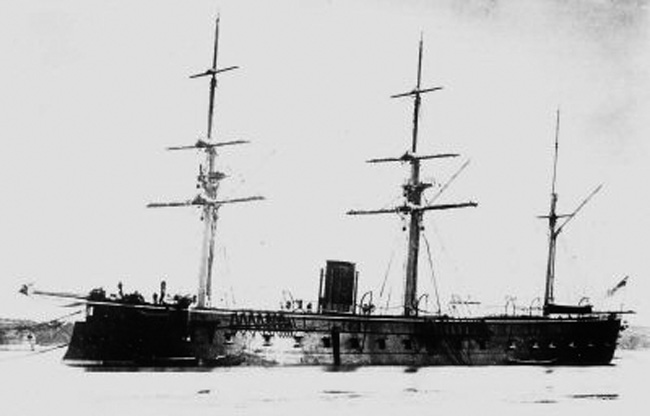
Friedrich Carl in 1867
Friedrich Carl was active until 1895, until leaving front-line service and becoming a training ship. When the Franco-Prussian War in 1870–1871 flared uup she was part of the main German squadron under Vizeadmiral Eduard von Jachmann. But her engine trouble as other vessels in the squadron saw her making only two sorties from Wilhelmshaven to challenged the blockade. In 1873 she was in during the insurrection, protecting German citizens and seizing of rebel ships. After ha great refit in Wilhelmshaven in the 1880s she was finally decommissioned as a TS in 1895 but soon renamed Neptun in 1902, harbor ship until June 1905, stricken, sold for scrap the next year.
Development
The Danish Rivalry
Following the acquisition of Arminius and Prinz Adalbert, both very similar, small, French built Ironclads more suited for coastal areas, the Prussian Navy wanted at least a pair of sea going ironclads, capable of operating between thge Baltic and north sea. At the time, the main rival of Prussia was Denmark at sea, as the recent Second Schleswig War (1864) imposed a blockade of German ports that Prussia could not break. Ironclads being a recent development it was soon looked after the acquisition of an armored frigate, with a broadside battery, and potentially converted from a heavy wooden steam frigate. At the same time, the Danish Navy comprised notably the recently conferted Ironclad Dannebrog, a former ship of the line, as well as the line ships FREDERIK DEN SJETTE (1831), SKJOLD (1833), VALDEMAR (1828), the frigates HAVFRUEN (1825), JYLLAND (1862), Nield Juel (1856), SJÆLLAND (1860), THETIS (1840), TORDENSKJOLD (1852), two corvettes and a long serie of gunboats plus the ironclad monitor ROLF KRAKE (1863).
The Landtag or Prussian Parliament was however not convinced in 1865 to vote for an expanded budget to acquire new vessels, and this prompted King Wilhelm I to circumvent legislature, and by decree on 4 July overruled the Parliament and authorized the purchase of two armored frigates, jusged safer and faster than a conversion.
As another reminder, the Prussian Navy in 1865 had no ship of the line, 2 frigates (one captured from the Danes), 2 corvettes, 1 paddle frigate, about 42 small gunboats, transports and schooners. Until Arminius and Prinz Adalbert, she had no means to indeed break a blockade.
Comparing Designs
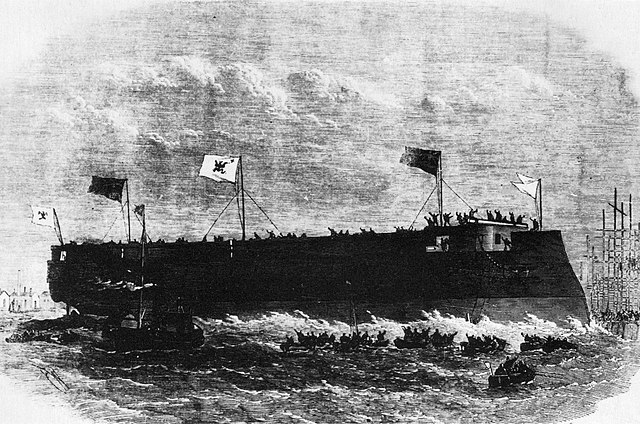
Launch of Friedrich Carl in Toulon, 1867
Britain and France being the leading shipbuilders for ironclads, the Preußische Marine chooses wisely to purchased on ironclad for each of these countries notably to gain experience and compare them before Prussian yards would be able to lay down new ships. The contract for Friedrich Carl was signed on 9 January 1866 after a tender, won by FCM in Toulon, while her sister followed four days later to Samuda Bros. in London. This despite of identical specs, the French-built Friedrich Carl ended very different from her half sister. FCM indeeed decided to model her on Couronne, albeit a smaller version. As a reminder, Couronne (Crown) was the largest ironclad in the French Navy at the time, displacing 6,428 t (6,326 long tons) and the first laid down specifically as such (Goire was converted). But Friedrich Carl ended smaller and quite different in many aspects, notably the machinery.
Design of the class
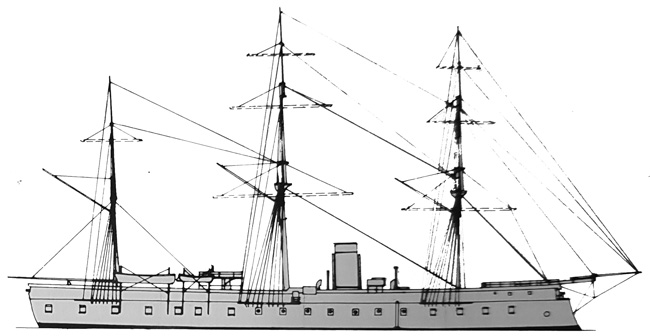
conway’s profile
Hull and general design
SMS Friedrich Carl measured 91.13 meters (299 ft) long at the waterline, 94.14 m (308 ft 10 in) long overall. She had a beam of 16.60 m (54 ft 6 in) and draft of 6.90 m (22 ft 8 in) forward, 8.05 m (26 ft 5 in) aft. As designed she was displacing 5,971 metric tons (5,877 long tons) at a normal load, up to 6,932t (6,823 long tons) with a full load. Construction was all-metal and called for transverse and longitudinal iron frames, she also had eight watertight compartments under the waterline, plus a a double bottom running for 76% of her lenght. Externally, she showed a ram bow, three masts with a barque rigging and tall bulwarks to protect her weather deck guns with a main bridge located after of the mizzenmast, with a cabin like bridge topped by a walkway, and in 1890 at least, it was occupied by two light projectors.
Friedrich Carl on trials showed she was excellent sea boat, responsive from the helm, with a moderate turning radius from her single, large rudder. However she seemed unbalanced, as a 6° rudder to port was required her to stay on a straight course. Her crew comprised 33 officers and 498 ratings, Friedrich Carl was protected by wrought iron plating, backed by heavy teak planking, which was traditional in French armour scheme at least until the start of the century, teak being used to buffer the effect of an impact. The waterline armored belt was 114 millimeters (4.5 in) thick, backed with 254 mm (10 in) of teak. There was along the battery a strake of plating also 114 mm thick but backed by 260 mm (10.2 in) of teak around the central battery. Its roof was protected by 9 mm (0.35 in) iron plating only to deflect shots passing over its side as well as fragments. Friesrich Carl also had a conning tower, still walled by 114 mm thick iron plating, backed by 400 mm (15.7 in) of teak. As built, Friedrich Carl had twenty-six rifled 72-pounder cannon as orioginally planned. however after delivery they were replaced two Krupp 21-centimeter (8.3 in) L/22 guns (lange) and fourteen 21-centimeter (8.3 in) L/19 (Kurze) guns. The L/19 guns were in the main central battery amidships, seven per broadside whereas the L/22 guns wtre at either end as chase guns. A later 1880s upgrade saw the installation of six 37 mm (1.5 in) Hotchkiss revolver cannon and five 35 cm (14 in) torpedo tubes, two at the bow, two on the sides, one in the stern, port side, above the waterline, with twelve torpedoes in reserve. She ended her career that way.Powerplant
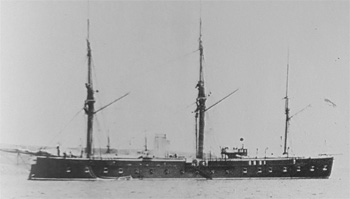 Fred Carl was fitted with an horizontal, two-cylinder single-expansion steam engine. It was driving a four-bladed screw propeller which was generous in size, typival of these low-rev early models, on six meters or 19 ft 8 in in diameter. The machinery was fed by steam coming from six trunk boilers, that for safety were placed in two separate boiler rooms. Each of these boilers comprised eleven fireboxes for a steam pressure of 2 standard atmospheres (200 kPa). They were vented into a single funnel amindship. This ensemble was rated for 3,300 metric horsepower (3,255 ihp) for a top speed of 13 knots (24 km/h; 15 mph), exceeded on trials to 3,550 PS (3,501 ihp) and 13.5 knots (25.0 km/h; 15.5 mph). For range, she carried 624 t (614 long tons) of coal, enough for 2,210 nautical miles (4,090 km; 2,540 mi) at 10 knots (19 km/h; 12 mph). This was completed by a complete barque rig with a surface area of 2,010 square meters. It could provide one more knot if the winds were favourable. It seems she kept her rigging intact until the end of her service in the 1890s according to photos.
Fred Carl was fitted with an horizontal, two-cylinder single-expansion steam engine. It was driving a four-bladed screw propeller which was generous in size, typival of these low-rev early models, on six meters or 19 ft 8 in in diameter. The machinery was fed by steam coming from six trunk boilers, that for safety were placed in two separate boiler rooms. Each of these boilers comprised eleven fireboxes for a steam pressure of 2 standard atmospheres (200 kPa). They were vented into a single funnel amindship. This ensemble was rated for 3,300 metric horsepower (3,255 ihp) for a top speed of 13 knots (24 km/h; 15 mph), exceeded on trials to 3,550 PS (3,501 ihp) and 13.5 knots (25.0 km/h; 15.5 mph). For range, she carried 624 t (614 long tons) of coal, enough for 2,210 nautical miles (4,090 km; 2,540 mi) at 10 knots (19 km/h; 12 mph). This was completed by a complete barque rig with a surface area of 2,010 square meters. It could provide one more knot if the winds were favourable. It seems she kept her rigging intact until the end of her service in the 1890s according to photos.Armament
The L/22 were capable of a −5 degrees + 13 degrees traverse, enabling a range of 5,900 m (6,500 yd).
The L/19 guns could elevate down to −8 and up to 14.5 degrees, marred by the shorter barrel making for a range of 5,200 m (5,700 yd).
They shared the same shells for a total of 1,656 rounds between them.
⚙ specifications
Displacement
6,932 t (6,823 long tons)
Dimensions
94.14 x 16.60 x 6.90m (308 ft 10 in x 54 ft 6 in x 22 ft 8 in)
Propulsion
1× shaft VSE engine, 6 × boilers: 3,550 PS (3,501 ihp) +Barque-rigged
Speed
13.5 knots (25.0 km/h; 15.5 mph)
Range
2,210 nmi (4,090 km; 2,540 mi) at 10 knots (19 km/h; 12 mph)
Armament
2× 21 cm (8.3 in) L/22 guns, 14 × 21 cm (8.3 in) L/19 guns
Protection
Waterline belt: 127 mm (5 in), Conning tower: 114 mm (4.5 in)
Crew
33 officers+ 498 enlisted men
Career of Friedrich Carl
Friedrich Carl was completed before the end of 1867 and was delivered to Prussia and commissioned on 3 October. Crews were carried at Toulon by the screw frigate Hertha and the screw corvette Medusa. The other in Britain. Both ironclads were laid up however without any armament as their intended guns had serious failures during testing in 1867–1868. In particular their Kreiner breech blocks failed. Krupp-designed guns replaced them, and it’s not before July 1869 that they were armed. in June 1870, Friedrich Carl collided with the Danish schooner Auguste Robert, in the Dogger Bank, but Dutch fishermen rescued them.
As the Franco-Prussian War started in 1870, the Prussian Navy’s only role was to try to break the French naval blockade, on paper much larger htan the Danish one. But unlike in the first one, France hjad no infrastructure support and could not travel without massive coal reserves. Friedrich Carl and Kronprinz as well König Wilhelm, and Prinz Adalbert had been caught off-guard in the English Channel training before the French declared war. They left Plymouth on 10 July and were en route to Fayal in the Azores. On the 13th they learned of the rising tension and they returned to Wilhelmshaven, reaching the port on 16 July. War started on 19 July. Friedrich Carl, Kronprinz, and König Wilhelm patrolled the North Sea and off Wilhelmshaven, joined there by Arminius, until then stationed in Kiel.
Due to unsufficient planning the French planed assault on the Prussian naval installations, was proven soon impossible without Danish assistance, which was denied. Thus, Fred carl, under the formation led by Vizeadmiral Eduard von Jachmann made a sortie in early August 1870 off the Dogger Bank, but ade no spotting of any French ships and this revealed also engine issues with Friedrich Carl and two others, chronic, but serious, so much so they had to fold down leaving alone Arminius. Friedrich Carl, Kronprinz, and König Wilhelm stood next were stationed at Wangerooge and Arminius was stationed in the mouth of the Elbe river given their respective capabilities. On 11 September the three ironclads joined Arminius for a swoop in the North Sea but did not encounter French warships. Indeed at that time the naval staff was ordered to cease operations, reported hopeless and returned to France. Ships were disarmed and sailors converted into troops.
Postwar, the German armored fleet only trained in the summer, the crew was disbanded the rest of the year. The ships otherwise were in reserve with one or two in reduced commission, guard ships. By June 1871, the corvette Nymphe was in Brazil where part of her crew was arrested after a fistfight and jailed. The Germans threatened to deploy the fleet and the Brazilian was forved to release the crewmen. From September 1872, Friedrich Carl started a world cruise with SMS Elisabeth and the gunboat Albatross, later joined by Vineta and Gazelle while in the Caribbean Sea.
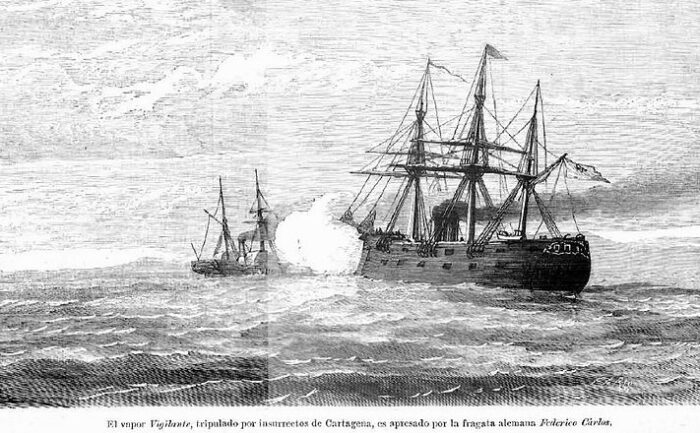
Illustration of the action between Friedrich Carl and the rebel steamer Vigilante
In early 1873, the Spanish Republic early days were compromised by the Cantonal Revolution. Friedrich Carl sailed under command of Vizeadmiral Reinhold Werner to Spain with two unarmored vessels, joining a British squadron patrolling the southern coast. A rebel Carlist faction seized four ironclads and now presented a real menace for the legitimate Republic. The Anglo-German force present passed under German command and blockaded two rebel ironclads in Cartagena after they had shelled a coastal town. Later while off Alicante, Friedrich Carl crossed the steamer Vigilante, challenged, reaveling itself a rebel ships. Boarded, seized, she was returned it to the national government.
Friedrich Carl teamed with HMS Swiftsure to attack and attempt to siez the ironclads Vitoria and Almansa, but without authorization. The later indeed besieged Almería and wanted its gold reserves. There was a brief engagement, in which the well trained crews of both Ironclads overwhelmed the rebels, seizing both, soon turned over to the Spanish government. Friedrich Carl also detained a captured rebel leader but the Anglo-German blockade eventually forced the rebels to surrender. Chancellor Otto von Bismarck at the return of the ironclad however court-martial Werner, which acted without orders. He will strongly prohibited “gunboat diplomacy” from then on.
Later service
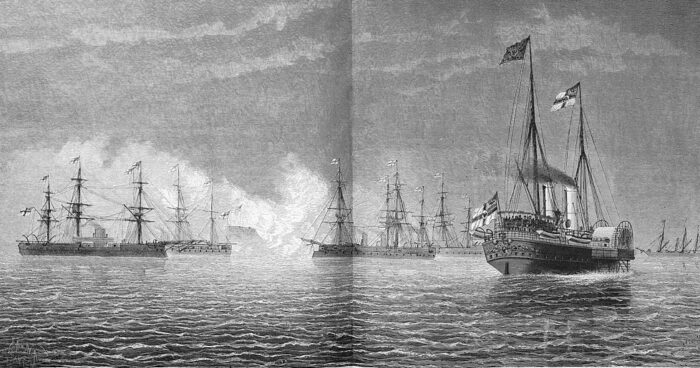
Illustration of the fleet conducting maneuvers, including Friedrich Carl and several other ironclads and other vessels
In 1876, the Kronprinz (flag), Friedrich Carl, and SMS Kaiser, Deutschland sailed to the Mediterranean Sea after the murder of the German consul in Salonika, Ottoman Empire. There, they met French, Russian, Italian, and Austro-Hungarian warships condemning the murder. After coppensation and escuses were obtained, Fred Carl sailed back home in August and, being laid up for the winter. She made another Mediterranean cruise in 1877, with the same ships and new turret ship Preussen and aviso Falke. They stopped in Aegean Sea and Levant ports along. However the now old Friedrich Carl remained laid in 1878. She was reactivated by May 1879, as flagship of the training squadron with Kronprinz, Preussen, Friedrich der Grosse and until 1883. She took part in the large-scale simulated attack on Kiel as part of the “eastern” opponent. The novelty is that they operated entirely under steam power.
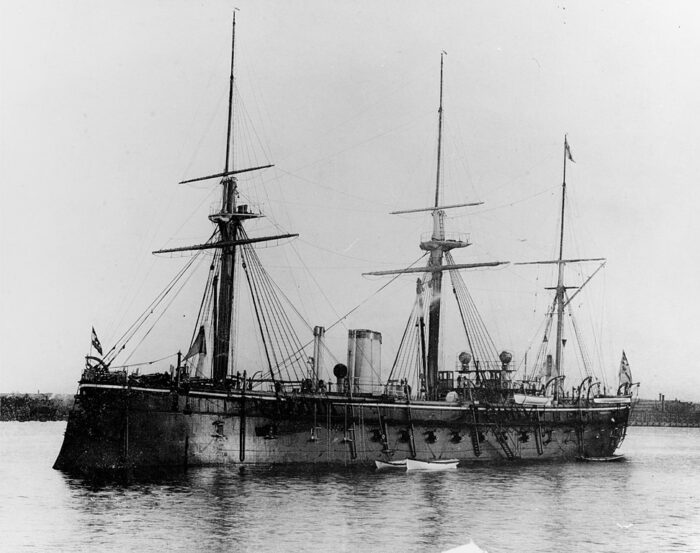
Fredrich Carl in 1896, not she still had her rigging
In 1885, Friedrich Carl saw the installation of torpedo nets, until 1897. Her 1885 refit, saw the installation of new German cast boilers, modified funnel with second uptake installed and as said above, addition of six 37 mm Hotchkiss guns, five torpedo tubes. She took part as this in the 1885 maneuvers with Bayern and Hansa. In 1887, she took part in the Kaiser Wilhelm Canal construciton opening. In 1895 she was estimated way too old, and was disarmed plus kept as a torpedo test ship from 11 August and until 21 January 1902. By then she was renamed Neptun, used as a harbor ship. Her name was indeed freed for the new armoured cruiser Friedrich Carl launched on 22 June 1902. Neptun was stricken on 22 June 1905, sold in March 1906 for 284,000 gold marks, towed to the Netherlands and BU.
Read More/Src
Books
Dodson, Aidan (2016). The Kaiser’s Battlefleet: German Capital Ships 1871–1918. Barnsley: Seaforth Publishing. ISBN 978-1-84832-229-5.
Greene, Jack & Massignani, Alessandro (1998). Ironclads at War: Origin and Development 1854–1891. Combined Publishing.
Gröner, Erich (1990). German Warships: 1815–1945. Vol. I: Major Surface Vessels. NIP
Lyon, Hugh (1979). “Germany”. In Gardiner, Robert; Chesneau, Roger; Kolesnik, Eugene M. (eds.). Conway’s All the World’s Fighting Ships 1860–1905.
Erich Gröner, Dieter Jung, Martin Maass: Die deutschen Kriegsschiffe 1815–1945. Bernard & Graefe Verlag, Koblenz 1989.
Mirko Graetz: Prinz Adalberts vergessene Flotte. Die Norddeutsche Bundesmarine 1867–1871. Lulu Enterprises Inc.
Clas Broder Hansen: Deutschland wird Seemacht. Urbes Verlag, Gräfelfing 1991.
Hans Jürgen Hansen: Die Schiffe der deutschen Flotten 1848–1945. Urbes Verlag, Gräfelfing 1998.
Paul Schmalenbach: Die Geschichte der deutschen Schiffsartillerie. Koehlers Verlagsgesellschaft, Herford 1993.
Sondhaus, Lawrence (2001). Naval Warfare, 1815–1914. London: Routledge.
Wilson, Herbert Wrigley (1896). Ironclads in Action: A Sketch of Naval Warfare from 1855 to 1895. London: S. Low, Marston and company.
Links
https://marinefreunde.com/deu/dhj61.html
http://www.dreadnoughtproject.org/tfs/index.php/S.M.S._Friedrich_Carl_(1867)
https://de.wikipedia.org/wiki/Friedrich_Carl_(Schiff,_1867)
https://en.wikipedia.org/wiki/SMS_Friedrich_Carl_(1867)
https://www.navalhistory.dk/English/Naval_Lists/Periods/1864.htm
https://www.navalhistory.dk/English/Naval_Lists/Periods/1864.htm
https://timelessmoon.getarchive.net/amp/media/sms-friedrich-carl-1896-2f2a95
Model Kits
https://www.klueser.de/kit.php?index=4661&language=en

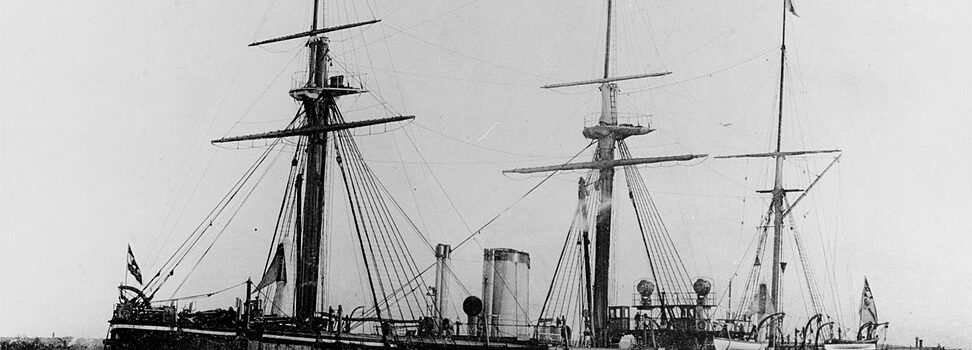
 Latest Facebook Entry -
Latest Facebook Entry -  X(Tweeter) Naval Encyclopedia's deck archive
X(Tweeter) Naval Encyclopedia's deck archive Instagram (@navalencyc)
Instagram (@navalencyc)





 French Navy
French Navy Royal Navy
Royal Navy Russian Navy
Russian Navy Armada Espanola
Armada Espanola Austrian Navy
Austrian Navy K.u.K. Kriegsmarine
K.u.K. Kriegsmarine Dansk Marine
Dansk Marine Nautiko Hellenon
Nautiko Hellenon Koninklije Marine 1870
Koninklije Marine 1870 Marinha do Brasil
Marinha do Brasil Osmanlı Donanması
Osmanlı Donanması Marina Do Peru
Marina Do Peru Marinha do Portugal
Marinha do Portugal Regia Marina 1870
Regia Marina 1870 Nihhon Kaigun 1870
Nihhon Kaigun 1870 Preußische Marine 1870
Preußische Marine 1870 Russkiy Flot 1870
Russkiy Flot 1870 Svenska marinen
Svenska marinen Søværnet
Søværnet Union Navy
Union Navy Confederate Navy
Confederate Navy Armada de Argentina
Armada de Argentina Imperial Chinese Navy
Imperial Chinese Navy Marinha do Portugal
Marinha do Portugal Mexico
Mexico Kaiserliche Marine
Kaiserliche Marine 1898 US Navy
1898 US Navy Sovietskiy Flot
Sovietskiy Flot Royal Canadian Navy
Royal Canadian Navy Royal Australian Navy
Royal Australian Navy RNZN Fleet
RNZN Fleet Chinese Navy 1937
Chinese Navy 1937 Kriegsmarine
Kriegsmarine Chilean Navy
Chilean Navy Danish Navy
Danish Navy Finnish Navy
Finnish Navy Hellenic Navy
Hellenic Navy Polish Navy
Polish Navy Romanian Navy
Romanian Navy Turkish Navy
Turkish Navy Royal Yugoslav Navy
Royal Yugoslav Navy Royal Thai Navy
Royal Thai Navy Minor Navies
Minor Navies Albania
Albania Austria
Austria Belgium
Belgium Columbia
Columbia Costa Rica
Costa Rica Cuba
Cuba Czechoslovakia
Czechoslovakia Dominican Republic
Dominican Republic Haiti
Haiti Hungary
Hungary Honduras
Honduras Estonia
Estonia Iceland
Iceland Eire
Eire Equador
Equador Iran
Iran Iraq
Iraq Latvia
Latvia Liberia
Liberia Lithuania
Lithuania Mandchukuo
Mandchukuo Morocco
Morocco Nicaragua
Nicaragua Persia
Persia San Salvador
San Salvador Sarawak
Sarawak Uruguay
Uruguay Venezuela
Venezuela Zanzibar
Zanzibar Warsaw Pact Navies
Warsaw Pact Navies Bulgaria
Bulgaria Hungary
Hungary

 Bundesmarine
Bundesmarine Dutch Navy
Dutch Navy Hellenic Navy
Hellenic Navy Marina Militare
Marina Militare Yugoslav Navy
Yugoslav Navy Chinese Navy
Chinese Navy Indian Navy
Indian Navy Indonesian Navy
Indonesian Navy JMSDF
JMSDF North Korean Navy
North Korean Navy Pakistani Navy
Pakistani Navy Philippines Navy
Philippines Navy ROKN
ROKN Rep. of Singapore Navy
Rep. of Singapore Navy Taiwanese Navy
Taiwanese Navy IDF Navy
IDF Navy Saudi Navy
Saudi Navy Royal New Zealand Navy
Royal New Zealand Navy Egyptian Navy
Egyptian Navy South African Navy
South African Navy






























 Ukrainian Navy
Ukrainian Navy dbodesign
dbodesign